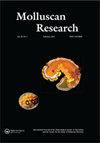First live imagery, morphological insights, and new locations of the near-threatened endemic microsnail Sheitanok amidicus (Caenogastropoda: Hydrobiidae) from southeast Turkey
IF 0.6
4区 生物学
Q3 ZOOLOGY
引用次数: 0
Abstract
ABSTRACT This study presents new insights into the near-threatened endemic microsnail Sheitanok amidicus (Schütt & Şeşen, 1991), shedding light on its distribution and morphological characteristics, which have never been documented alive. Surveys conducted in 2023 uncovered two previously unknown localities where the species thrives: stenothermic springs in Tavşantepe village and a private farm in Diyarbakır, Turkey. The snail has whitish-grey body tissue, tentacles with an average length of 0.3 mm, and a foot extending up to 2 mm with grey dots on the upper part. The oval-shaped operculum has an average height and width of 0.4 and 0.3 mm, respectively. The shell width and height is 1.0 mm and 0.7 mm, respectively. The snail has unique features including an orange operculum, heart-shaped blackish mouth parts and two blackish eyes at the base of its tentacles. Previously, the species was known to inhabit seven locations in Southeast Turkey. Its near-threatened status on the IUCN Red List highlights the urgency of conservation efforts. The identification of these new locations provides hope for reducing the risk of extinction for S. amidicus. Additionally, describing the snail's external characteristics would aid in systematic classification of newly found species within this monotypic genus.土耳其东南部濒临灭绝的地方性微小指甲Sheitanok amidicus(软体动物纲:水螅科)的首次现场图像、形态学见解和新位置
本文章由计算机程序翻译,如有差异,请以英文原文为准。
求助全文
约1分钟内获得全文
求助全文
来源期刊

Molluscan Research
生物-动物学
CiteScore
1.80
自引率
10.00%
发文量
27
审稿时长
>12 weeks
期刊介绍:
Molluscan Research is an international journal for the publication of authoritative papers and review articles on all aspects of molluscan research, including biology, systematics, morphology, physiology, ecology, conservation, biogeography, genetics, molecular biology and palaeontology.
While the scope of the journal is worldwide, there is emphasis on studies relating to Australasia and the Indo-west Pacific, including East and South East Asia. The journal’s scope includes revisionary papers, monographs, reviews, theoretical papers and briefer communications. Monographic studies of up to 73 printed pages may also be considered.
The journal has been published since 1957 (as the Journal of the Malacological Society of Australia until 1993). It is free to members of the Malacological Society of Australasia and the Society for the Study of Molluscan Diversity.
 求助内容:
求助内容: 应助结果提醒方式:
应助结果提醒方式:


